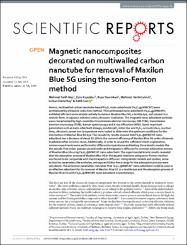| dc.contributor.author | Nas, Mehmet Salih | |
| dc.contributor.author | Kuyuldar, Esra | |
| dc.contributor.author | Demirkan, Buse | |
| dc.contributor.author | Çalımlı, Mehmet Harbi | |
| dc.contributor.author | Demirbaş, Özkan | |
| dc.contributor.author | Şen, Fatih | |
| dc.date.accessioned | 2021-01-05T10:46:18Z | |
| dc.date.available | 2021-01-05T10:46:18Z | |
| dc.date.issued | 2019 | en_US |
| dc.identifier.issn | 2045-2322 | |
| dc.identifier.uri | https://doi.org/10.1038/s41598-019-47393-0 | |
| dc.identifier.uri | https://hdl.handle.net/20.500.12462/10941 | |
| dc.description | Demirbaş Özkan (Balikesir Author) | en_US |
| dc.description.abstract | Herein, multiwalled carbon nanotube-based Fe3O4 nano-adsorbents (Fe3O4@MWCNT) were synthesized by ultrasonic reduction method. The synthesized nano-adsorbent (Fe3O4@MWCNT) exhibited efficient sonocatalytic activity to remove Maxilon Blue 5G, a textile dye, and present in a cationic form, in aqueous solution under ultrasonic irradiation. The magnetic nano-adsorbent particles were characterized by high-resolution transmission electron microscopy (HR-TEM), transmission electron microscopy (TEM), Raman spectroscopy and X-ray diffraction (XRD). Some important parameters such as nano-adsorbent dosage, solution pH, initial dye and H2O2 concentration, reaction time, ultrasonic power and temperature were tested to determine the optimum conditions for the elimination of Maxilon Blue 5G dye. The reusability results showed that Fe3O4@MWCNT nano-adsorbent has a decrease of about 32.15% in the removal efficiency of Maxilon Blue 5G under ultrasonic irradiation after six times reuse. Additionally, in order to reveal the sufficient kinetic explanation, various experiments were performed at different temperatures and testing three kinetic models like the pseudo-first-order, pseudo-second-order and intraparticle diffusion for removal adsorption process of Maxilon Blue 5G using Fe3O4@MWCNT nano-adsorbent. The experimental kinetic results revealed that the adsorption process of Maxilon Blue 5G in the aquatic mediums using sono-Fenton method was found to be compatible with the intraparticle diffusion. Using kinetic models and studies, some activation parameters like enthalpy, entropy and Gibbs free energy for the adsorption process were calculated. The activation parameters indicated that Fe3O4@MWCNT nano-adsorbent could be used as an effective adsorbent for the removal of Maxilon Blue 5G as a textile dye and the adsorption process of Maxilon Blue 5G with Fe3O4@MWCNT nano-adsorbent is spontaneous. | en_US |
| dc.language.iso | eng | en_US |
| dc.publisher | Nature Publishing Group | en_US |
| dc.relation.isversionof | 10.1038/s41598-019-47393-0 | en_US |
| dc.rights | info:eu-repo/semantics/openAccess | en_US |
| dc.subject | Methylene-blue | en_US |
| dc.subject | Catalytic Degradation | en_US |
| dc.subject | Textile Dye | en_US |
| dc.subject | Discharge Plasma | en_US |
| dc.subject | Aqueous-solution | en_US |
| dc.subject | Charge-transfer | en_US |
| dc.subject | Bisphenol-a | en_US |
| dc.subject | Adsorption | en_US |
| dc.subject | Nanoparticles | en_US |
| dc.subject | Ultrasound | en_US |
| dc.title | Magnetic nanocomposites decorated on multiwalled carbon nanotube for removal of Maxilon Blue 5G using the sono-Fenton method | en_US |
| dc.type | article | en_US |
| dc.relation.journal | Scientific Reports | en_US |
| dc.contributor.department | Fen Edebiyat Fakültesi | en_US |
| dc.contributor.authorID | 0000-0001-6843-9026 | en_US |
| dc.contributor.authorID | 0000-0001-9929-9556 | en_US |
| dc.contributor.authorID | 0000-0001-9548-0227 | en_US |
| dc.identifier.volume | 9 | en_US |
| dc.identifier.startpage | 1 | en_US |
| dc.identifier.endpage | 11 | en_US |
| dc.relation.publicationcategory | Makale - Uluslararası Hakemli Dergi - Kurum Öğretim Elemanı | en_US |


















